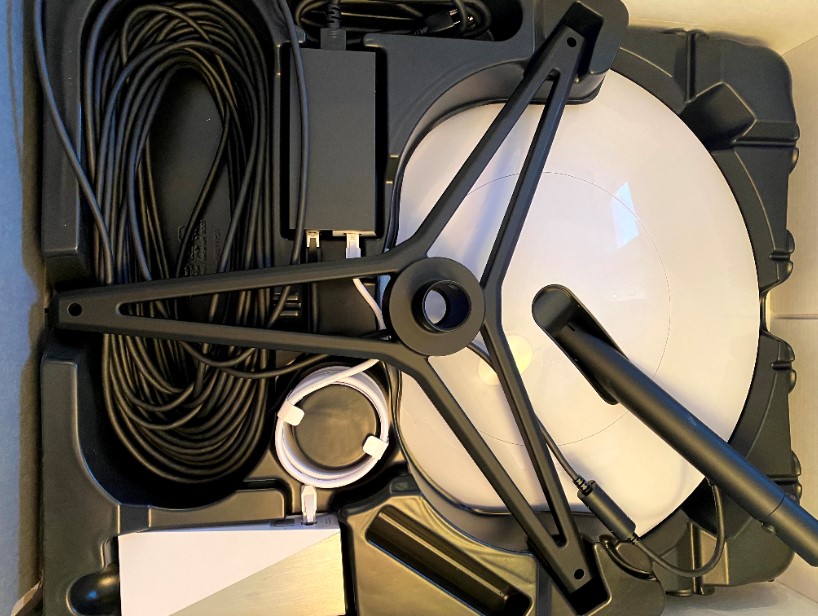For those who live in rural or remote areas, finding quality, reliable, or even usable broadband Internet can be challenging. The good news is that this is about to change and change in a big way. Elon Musk's new broadband, satellite-based Internet service is straight out of science fiction, and it’s just now coming online. This multi-part series will dig into how this service works, how to set it up, troubleshooting, and even how to integrate it into your existing network.
Starlink just recently came out of private beta and is now in public beta. It’s an early public beta, to say the least. Starlink even has a special name for it: "Better than nothing beta." According to the company: Expect to see data speeds vary from 50Mb/s to 150Mb/s and latency from 20ms to 40ms over the next several months as we enhance the Starlink system. There will also be brief periods of no connectivity at all. I'm personally seeing these exact speeds, and every couple of hours, we will lose Internet connectivity for 30 seconds to two minutes. This happens when there isn't a satellite close enough to our dish (more on that, later). The good news is that this interruption of service is a temporary issue and will be solved in the coming months as more satellites are launched.
If you would like to give this new service a spin, head on over to Starlink.com and sign up for the beta. Right now, we believe the service is limited to southern Canada and the Pacific Northwest around Washington, Idaho, and Montana. As more satellites are launched, the service will become faster, more reliable, and will eventually cover nearly the entire globe.
The satellite dish (nicknamed Dishy McFlatface by Starlink engineers) will run you $499 plus tax and shipping, and then $99/month. Everything you need will arrive in a large box and comes nearly fully assembled. Just connect the dish to the stand, plug in the power, and wait for the dish to find an overhead satellite. We'll go over the setup in detail and even how to add this Internet service to your existing home network in a future article.
You may be asking yourself why this is such a big deal. After all, we have had satellite-based Internet service for many years. These satellites are in geostationary Earth orbit or GEO. They appear to be stationary above a fixed point on earth. The problem with these older systems has to do with how far away the satellite is from the earth – over 22,000 miles. At those distances, it can take quite a long time for the data to travel from the website to the satellite and into your home. That's well over 40,000 miles! If you have ever wondered why your legacy satellite service is slow, this is why.
Starlink takes a different approach. Their low-earth orbiting satellites are much closer to the earth – only about 5,000 miles above you. This greatly reduces the round trip that the radio signals need to take to get the data packet to you. The downside to this method is that because the satellites are so close to the earth, they cannot stay in a GEO orbit and are constantly moving around the earth. At this point, you're probably asking yourself, "if they're constantly moving, how will I be able to receive an Internet signal?" You have no doubt had a conversation on your mobile phone while traveling a long distance in your car. The call (most of the time) continues uninterrupted as you speak. You don't realize that it is happening. Still, your phone is constantly negotiating with the surrounding antennas that service the adjacent cells and switches to a closer antenna as you travel into that cell (hence the name, cellphone). Starlink satellites work in a similar way, except this time, you are stationary, and the antennas are moving. This brings us back to why the Starlink Internet service sometimes drops out while we are in beta. There simply are not quite enough satellites to cover the entire surface of where I live in Washington State. My Dishy McFlatface looks for a new satellite when the current signal starts to get weak, but it cannot find one, so I lose the Internet. The good news is that it is very temporary and will be solved as soon as more satellites are put into service. There's a reason they are calling this their "better than nothing" beta. But even with a few glitches, it's pretty darn good.
There is still so much more that I want to share with you, but I have run out of space. Come back next month when we will continue this discussion and cover topics such as:
- Unboxing
- Setup
- Mounting to your house
- Troubleshooting
- Connecting to your existing home network
- Speed/Performance
- Mobile app functionality/use
- Account website functionality/use
If you try to sign up for the beta and find that it’s closed or not yet available in your area (because you live too far south or in a country other than the United States), don’t worry. Starlink will be coming to you soon.
Until next time...











